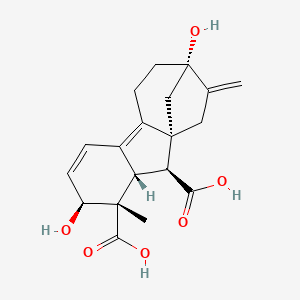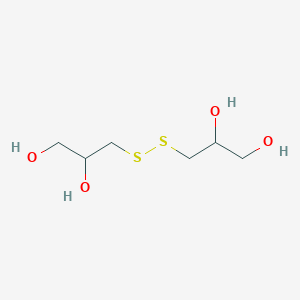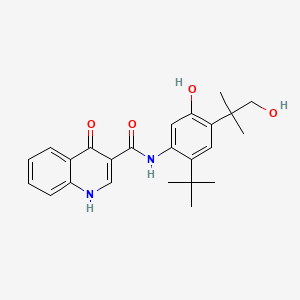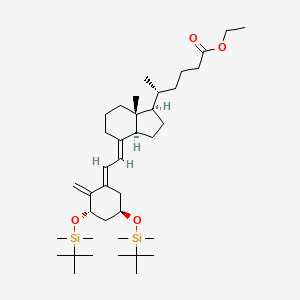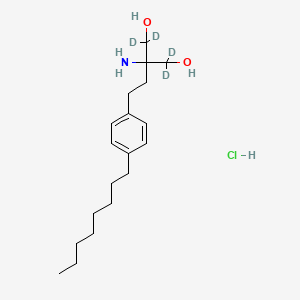
FTY720-d4 Hydrochloride
Vue d'ensemble
Description
Fingolimod-D4 Hydrochloride is a labelled analogue of Fingolimod. Fingolimod is an immunosuppressive agent used for the treatment of relapsing multiple sclerosis. It is a sphingosine-1-phosphate receptor modulator preventing lymphocyte emigration to participate in the autoimmune reaction.
Mécanisme D'action
Target of Action
Fingolimod-d4 Hydrochloride, also known as FTY720-d4 Hydrochloride, primarily targets the sphingosine 1-phosphate receptors (S1PRs) found on lymphocytes and other organs . The modulation of these receptors is crucial in managing multiple sclerosis (MS) symptoms .
Mode of Action
Fingolimod-d4 Hydrochloride acts as a sphingosine 1-phosphate receptor modulator . It is metabolized to its active form, fingolimod-phosphate, which binds to sphingosine 1-phosphate receptors 1, 3, 4, and 5 .
Biochemical Pathways
Fingolimod-d4 Hydrochloride affects several biochemical pathways. It induces metabolic reprogramming in brain regions, upregulating oxidative phosphorylation while downregulating glycolysis and the pentose phosphate pathway . It also modulates neuroinflammation by upregulating retrograde endocannabinoid signaling and autophagy pathways, and downregulating neuroinflammation-related pathways including neutrophil degranulation and the IL-12 mediated signaling pathway .
Pharmacokinetics
It’s known that the compound is given orally . More research is needed to fully understand the ADME properties of Fingolimod-d4 Hydrochloride and their impact on bioavailability.
Result of Action
The molecular and cellular effects of Fingolimod-d4 Hydrochloride’s action are profound. It reduces the number of lymphocytes in the peripheral blood, which is believed to be effective in treating MS due to the reduced lymphocytes into the CNS . It also induces numerous biological effects, including endothelial cell-cell adhesion, angiogenesis, vascular integrity, and cardiovascular function .
Action Environment
The action environment of Fingolimod-d4 Hydrochloride is primarily within the immune system and the CNS . The interaction with s1p receptors in various tissues accounts for the reported adverse effects
Analyse Biochimique
Biochemical Properties
Fingolimod-d4 Hydrochloride interacts with sphingosine 1-phosphate receptors (S1PRs) to bring about an array of pharmacological effects . It exerts inhibitory effects on sphingolipid pathway enzymes, inhibits histone deacetylases, transient receptor potential cation channel subfamily M member 7 (TRMP7), cytosolic phospholipase A2α (cPLA2α), reduces lysophosphatidic acid (LPA) plasma levels, and activates protein phosphatase 2A (PP2A) .
Cellular Effects
Fingolimod-d4 Hydrochloride has profound effects on various types of cells and cellular processes. It can profoundly reduce T-cell numbers in circulation and the CNS, thereby suppressing inflammation and MS . It also induces apoptosis, autophagy, cell cycle arrest, epigenetic regulations, macrophages M1/M2 shift and enhances BDNF expression .
Molecular Mechanism
Fingolimod-d4 Hydrochloride exerts its effects at the molecular level through several mechanisms. It binds to S1P receptor4 (S1PR4) that is primarily expressed in lymphocytes and hematopoietic tissues . It can induce apoptotic pathways by activation of caspase cascades, enhancing PTEN which inhibits pAkt, and inducing (ROS-JNK-p53) loop-dependent autophagy .
Temporal Effects in Laboratory Settings
It has been shown that the drug has a significant therapeutic effect in immunodeficient mice, not in immunocompetent mice .
Dosage Effects in Animal Models
In an animal model of genetic absence epilepsy, Fingolimod (1 mg/kg) showed transient antiepileptic effects and longer-lasting anti-cognition decline . During the chronic epileptic phase of the mouse kainate model, 6 mg/kg of the drug also showed neuroprotective and anti-gliotic effects besides reducing seizure frequency .
Metabolic Pathways
Fingolimod-d4 Hydrochloride is involved in the sphingosine 1-phosphate (S1P) pathway . It is phosphorylated to Fingolimod-phosphate by two protein kinases, type-1 and type-2 sphingosine kinase (SphK1 and -2), enabling it to interact with sphingosine receptors .
Transport and Distribution
It is known that Fingolimod binds to S1P receptor4 (S1PR4) that is primarily expressed in lymphocytes and hematopoietic tissues .
Subcellular Localization
It is known that Fingolimod activates PP2A that plays a principal role as a regulator of cell cycle/division and growth .
Propriétés
IUPAC Name |
2-amino-1,1,3,3-tetradeuterio-2-[2-(4-octylphenyl)ethyl]propane-1,3-diol;hydrochloride | |
|---|---|---|
| Source | PubChem | |
| URL | https://pubchem.ncbi.nlm.nih.gov | |
| Description | Data deposited in or computed by PubChem | |
InChI |
InChI=1S/C19H33NO2.ClH/c1-2-3-4-5-6-7-8-17-9-11-18(12-10-17)13-14-19(20,15-21)16-22;/h9-12,21-22H,2-8,13-16,20H2,1H3;1H/i15D2,16D2; | |
| Source | PubChem | |
| URL | https://pubchem.ncbi.nlm.nih.gov | |
| Description | Data deposited in or computed by PubChem | |
InChI Key |
SWZTYAVBMYWFGS-JWIOGAFXSA-N | |
| Source | PubChem | |
| URL | https://pubchem.ncbi.nlm.nih.gov | |
| Description | Data deposited in or computed by PubChem | |
Canonical SMILES |
CCCCCCCCC1=CC=C(C=C1)CCC(CO)(CO)N.Cl | |
| Source | PubChem | |
| URL | https://pubchem.ncbi.nlm.nih.gov | |
| Description | Data deposited in or computed by PubChem | |
Isomeric SMILES |
[2H]C([2H])(C(CCC1=CC=C(C=C1)CCCCCCCC)(C([2H])([2H])O)N)O.Cl | |
| Source | PubChem | |
| URL | https://pubchem.ncbi.nlm.nih.gov | |
| Description | Data deposited in or computed by PubChem | |
Molecular Formula |
C19H34ClNO2 | |
| Source | PubChem | |
| URL | https://pubchem.ncbi.nlm.nih.gov | |
| Description | Data deposited in or computed by PubChem | |
Molecular Weight |
348.0 g/mol | |
| Source | PubChem | |
| URL | https://pubchem.ncbi.nlm.nih.gov | |
| Description | Data deposited in or computed by PubChem | |
Synthesis routes and methods I
Procedure details





Synthesis routes and methods II
Procedure details







Retrosynthesis Analysis
AI-Powered Synthesis Planning: Our tool employs the Template_relevance Pistachio, Template_relevance Bkms_metabolic, Template_relevance Pistachio_ringbreaker, Template_relevance Reaxys, Template_relevance Reaxys_biocatalysis model, leveraging a vast database of chemical reactions to predict feasible synthetic routes.
One-Step Synthesis Focus: Specifically designed for one-step synthesis, it provides concise and direct routes for your target compounds, streamlining the synthesis process.
Accurate Predictions: Utilizing the extensive PISTACHIO, BKMS_METABOLIC, PISTACHIO_RINGBREAKER, REAXYS, REAXYS_BIOCATALYSIS database, our tool offers high-accuracy predictions, reflecting the latest in chemical research and data.
Strategy Settings
| Precursor scoring | Relevance Heuristic |
|---|---|
| Min. plausibility | 0.01 |
| Model | Template_relevance |
| Template Set | Pistachio/Bkms_metabolic/Pistachio_ringbreaker/Reaxys/Reaxys_biocatalysis |
| Top-N result to add to graph | 6 |
Feasible Synthetic Routes
Avertissement et informations sur les produits de recherche in vitro
Veuillez noter que tous les articles et informations sur les produits présentés sur BenchChem sont destinés uniquement à des fins informatives. Les produits disponibles à l'achat sur BenchChem sont spécifiquement conçus pour des études in vitro, qui sont réalisées en dehors des organismes vivants. Les études in vitro, dérivées du terme latin "in verre", impliquent des expériences réalisées dans des environnements de laboratoire contrôlés à l'aide de cellules ou de tissus. Il est important de noter que ces produits ne sont pas classés comme médicaments et n'ont pas reçu l'approbation de la FDA pour la prévention, le traitement ou la guérison de toute condition médicale, affection ou maladie. Nous devons souligner que toute forme d'introduction corporelle de ces produits chez les humains ou les animaux est strictement interdite par la loi. Il est essentiel de respecter ces directives pour assurer la conformité aux normes légales et éthiques en matière de recherche et d'expérimentation.
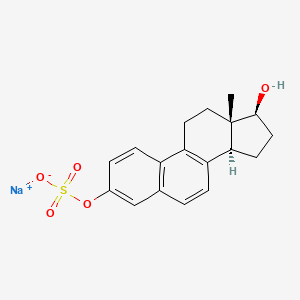

![13,17-dihydroxy-4-methyl-14-methylidene-5-oxo-6-oxapentacyclo[11.2.1.14,7.01,10.03,9]heptadec-8-ene-2-carboxylic acid](/img/structure/B602386.png)
